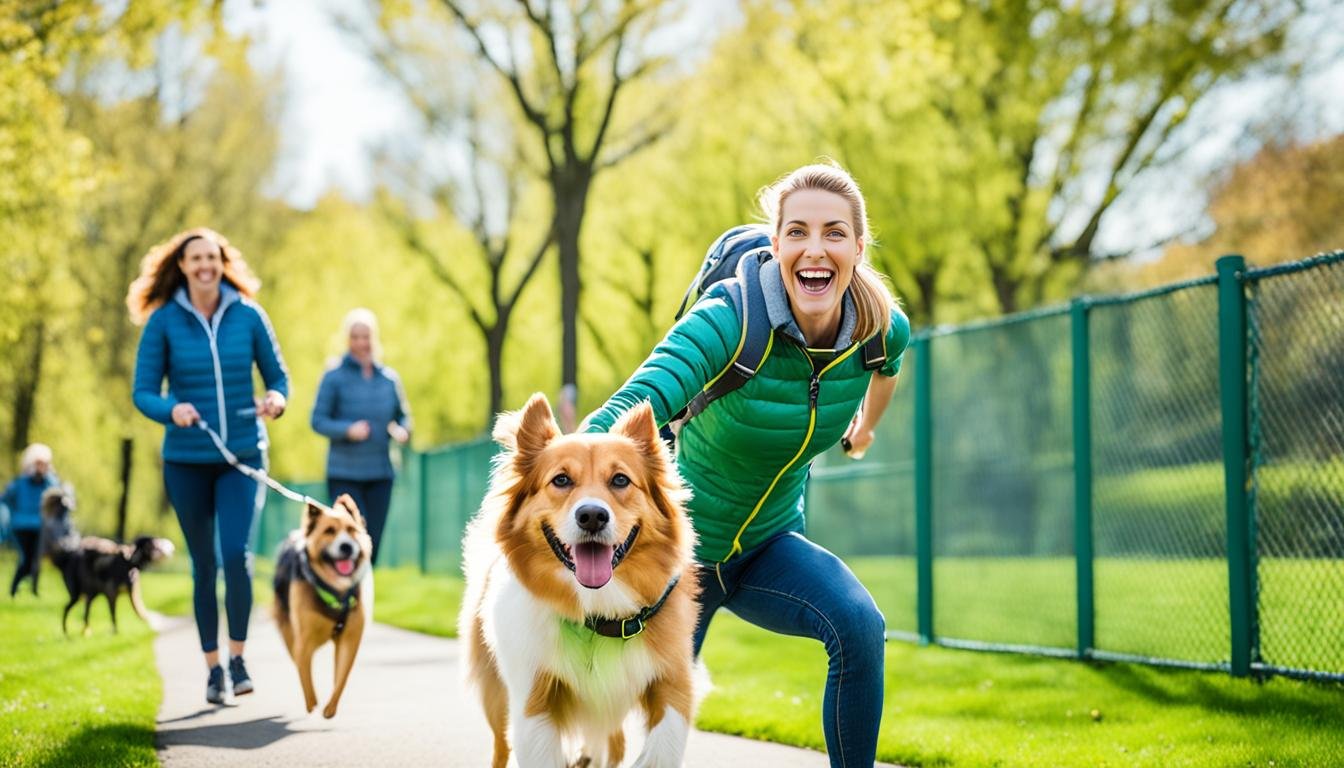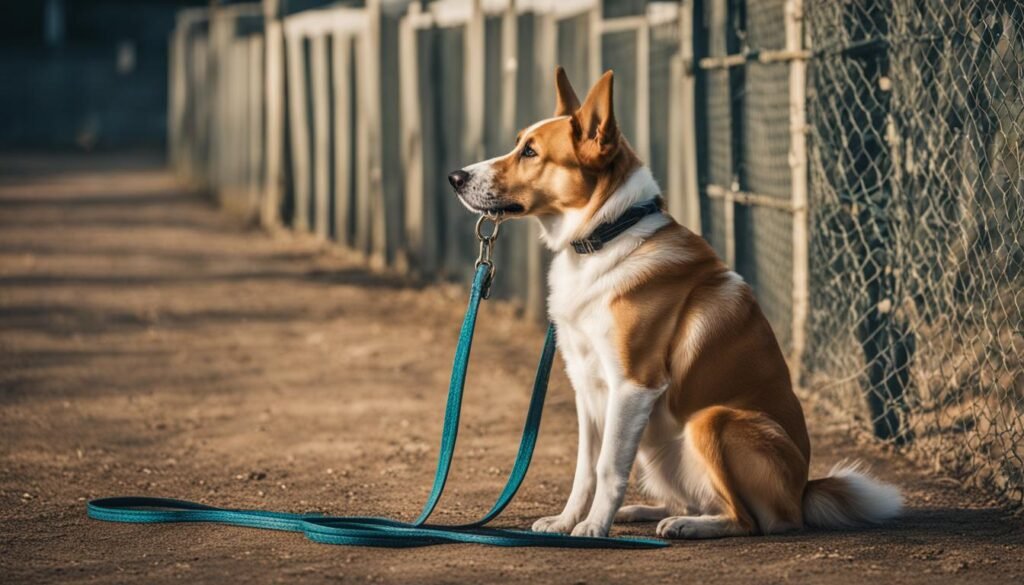
Did you know that there are millions of dogs in shelters and rescue organizations across the country, eagerly waiting for their forever homes? Making the decision to adopt a dog not only saves a life but also opens up a world of love and companionship. However, the journey of training a newly adopted dog can be challenging, as they may have missed important training and socialization during their earlier stages of life.
From understanding their body language to establishing structure and boundaries, this article will guide you through the process of adopting a dog and training them to become a well-adjusted member of your family. So, let’s dive in and discover the steps you can take to ensure a successful and rewarding training journey with your new canine companion.
Key Takeaways:
- Adopting a dog from a shelter or rescue organization can save a life and bring immense joy to your home.
- Newly adopted dogs may require additional training and socialization to thrive in their new environment.
- Understanding your dog’s body language is essential for effective communication and addressing any stress or anxiety they may experience.
- Establishing structure, rules, and boundaries will help your dog feel secure and understand their place in the family.
- House training and crate training are crucial aspects of creating a well-behaved and happy dog.
Understanding Your Dog’s Body Language
Understanding your dog’s body language is crucial for effective communication and building a stronger bond. Dogs rely on their body language to express their emotions and needs, and being able to interpret their cues can help you address any stress or anxiety they may be experiencing. By understanding and responding to your dog’s body language, you can prevent misunderstandings and create a more harmonious environment for both of you.
Here are some common signs of stress or discomfort that dogs may exhibit:
- Lip licking: Dogs may lick their lips when they are feeling nervous or anxious.
- Yawning: Excessive yawning can be a sign of stress in dogs.
- Panting: Dogs may pant when they are feeling hot or stressed.
- Avoiding eye contact: Dogs may avoid eye contact when they are feeling fearful or uncomfortable.
To deepen your understanding of your dog’s body language, you can utilize resources like the Dog Decoder app. This app provides valuable information on the different cues and behaviors exhibited by dogs, helping you interpret and respond effectively.
The Importance of Positive Reinforcement
When training your dog, positive reinforcement techniques can greatly enhance their learning experience and strengthen your bond. Positive reinforcement involves rewarding desired behaviors to encourage their repetition. By providing praise, treats, or playtime when your dog exhibits the desired behavior, you are reinforcing that behavior in a positive way.
Unlike punishment-based training methods, positive reinforcement focuses on encouraging the behaviors you want to see, rather than punishing unwanted behaviors. This approach promotes a more positive and enjoyable training experience for both you and your dog.
“Through positive reinforcement, you can motivate and empower your dog to learn and grow. It’s all about creating a happy and cooperative partnership.”
Establishing Structure, Rules, and Boundaries
When bringing a new dog into your home, it’s crucial to establish a sense of structure, clear rules, and boundaries. Dogs thrive when they know what is expected of them and feel secure in their environment. To help your new furry friend adjust and flourish, consider the following strategies:
- Set clear boundaries: Determine which areas of the house your dog is allowed in and establish rules such as not allowing them on furniture or jumping up on guests. Consistency is key in enforcing these boundaries.
- Use a leash for guidance: In the beginning, keep your dog on a leash inside the house to provide gentle guidance and prevent them from engaging in undesirable behaviors. This will also help with their obedience training.
- Provide proper crate rest: Investing in a suitable crate for your dog can serve as their safe haven and aid in establishing structure. Use positive reinforcement techniques to encourage them to view the crate as a cozy and comforting space.
- Implement structured walks: Regular walks not only provide physical exercise but also offer mental stimulation for your dog. Establish a structured routine for walks and practice loose leash walking techniques to ensure a calm and enjoyable walking experience for both of you.
Remember, training your dog through positive reinforcement methods is essential in reinforcing boundaries and creating a calm and well-adjusted dog in your home. Consider using the “Place” cue and engaging in crate games to further enforce these boundaries and build a strong foundation of obedience and respect.
By setting clear expectations and providing consistent guidance, you can establish structure, rules, and boundaries that will help your dog feel secure and thrive in their new home.

Testimonial from a Happy Dog Owner:
“Once we established clear rules and boundaries for our newly adopted dog, it made all the difference in the world. Not only did she become more confident and obedient, but our home also became a harmonious space where she could relax and thrive. It’s amazing how a structured routine can transform a dog’s behavior!” – Sarah Thompson, Dog Owner
House Training and Crate Training
House training and crate training are crucial components of training for newly adopted dogs. These training techniques help establish good bathroom habits and create a safe and secure environment for your dog. A combination of positive reinforcement and consistency is key to successful house training and crate training.
House Training Techniques for New Dogs
When house training a new dog, it’s important to establish a routine and be patient throughout the process. Here are some effective techniques:
- Take your dog outside frequently, especially after meals, naps, and playtime.
- Choose a designated spot where you want your dog to eliminate and consistently bring them to that location.
- Praise and reward your dog with treats or verbal praise immediately after they eliminate outside.
- Be consistent with your commands and use the same cue word, such as “go potty,” to associate it with the desired behavior.
Remember, accidents may happen during the house training process. If you catch your dog in the act, calmly interrupt them and immediately take them outside to finish eliminating. Avoid punishment, as it may only confuse and frighten your dog.
Comfort for your new companion
If you’re someone who loves pets and is passionate about adopting shelter dogs, then you definitely need to check out Slashop pet supplies. They have everything you need to ensure your new furry friend receives the best care and training possible.
One of the key aspects of adopting a shelter dog is training them to become the perfect companion. Slashop understands this and offers a wide range of training supplies specifically designed for adoptable dogs. From leashes and collars to crates and toys, they have it all. Their products are of high quality and are specially chosen to help you implement effective shelter dog training techniques.
Crate Training for Adopted Dogs
Crate training provides a safe and calming space for your dog when you can’t directly supervise them. Here are some tips for effective crate training:
- Choose an appropriately sized crate that allows your dog to stand, turn around, and lie down comfortably.
- Make the crate comfortable by providing a soft blanket or bed.
- Introduce your dog to the crate gradually, starting with short periods of time and gradually extending the duration.
- Use positive reinforcement techniques, such as crate games, to create a positive association with the crate.
During crate training, it’s important to remember that the crate should never be used as a form of punishment. It should be a safe and enjoyable space for your dog.
“Crate training provides a safe and calming space for your dog, teaches them to hold their bladder and bowels, and can aid in potty training.”
A well-trained and properly crate-trained dog can benefit from the sense of security and routine that a crate provides.

By implementing house training and crate training techniques, you can help your newly adopted dog develop good bathroom habits, feel secure in their crate, and become a well-adjusted member of your family.
Walking and Exercise
Walking and exercise are crucial for both physical and mental stimulation for your newly adopted dog. Regular walks provide an opportunity for them to explore their surroundings, socialize with other dogs, and expend energy. However, many rescue dogs may not have had much experience on a leash, making leash training an important aspect of their training journey.
When it comes to leash training, the goal is to teach your dog to walk calmly by your side. Start by using a proper-fitting harness and a comfortable leash. Begin with short walks in a low-distraction environment and gradually increase the duration and complexity of the walks. Use positive reinforcement techniques such as praise, treats, and clicker training to reward your dog for walking nicely on the leash.
It’s also important to balance structure with allowing your dog to explore and sniff their surroundings. While it’s essential to have a structured walking routine, releasing your dog to sniff and explore at appropriate times can fulfill their natural instincts and keep them mentally stimulated.
“Walking and exercise not only help release energy but also strengthen the bond between you and your dog.”
Regular exercise is not only beneficial for your dog’s physical health, but it also helps strengthen the bond between you and your furry companion. Engaging in physical activities such as jogging, hiking, or playing fetch in a secure area can help keep your dog fit and happy.
Working with a local trainer can provide invaluable guidance on leash training techniques and exercise routines that are tailored to your dog’s individual needs. They can also recommend appropriate tools, such as front-clip harnesses or head halters, to assist with leash training if needed.
Leash Training Tips
- Start leash training in a quiet, low-distraction environment.
- Use positive reinforcement techniques to reward desired behaviors.
- Gradually increase the duration and complexity of the walks.
- Allow your dog to sniff and explore at appropriate times.
- Consider using tools like front-clip harnesses or head halters if needed.
Exercise Routine Suggestions
Here is a sample exercise routine for your newly adopted dog:
| Activity | Duration | Frequency |
|---|---|---|
| Morning Walk | 30 minutes | Every day |
| Evening Playtime | 15-30 minutes | Every day |
| Training Session | 10-15 minutes | Every day |
| Weekend Adventure (Hiking/Beach) | 1-2 hours | Once a week |
A well-structured exercise routine combined with consistent leash training can lead to a happy and well-behaved dog. Remember to always prioritize your dog’s safety and well-being during physical activities.
Conclusion
Adopting a new dog and training them is an exciting and rewarding journey. By following the tips and methods outlined in this guide, you can create a happy and harmonious home for your furry friend. Remember, it takes time and patience to help your rescue dog adjust to their new environment.
One important aspect of successful dog training is understanding your dog’s body language. Paying attention to cues like lip licking, yawning, and avoiding eye contact can help you address any potential stress or anxiety. By learning to interpret and respond to your dog’s signals, you can strengthen your bond and prevent misunderstandings.
Establishing structure, rules, and boundaries is also key to creating a well-behaved dog. Setting clear boundaries and consistently enforcing rules will help your dog feel secure and know what behavior is expected of them. Positive reinforcement-based training methods, such as using treats and praise, can effectively reinforce these boundaries and create a calm and confident dog.
Finally, house training, crate training, and regular exercises are essential in promoting a balanced pet. Consistency, patience, and positive reinforcement are crucial during the training process. Remember to focus on establishing a routine, providing a safe and comfortable space for your dog, and engaging in structured walks to help them release energy and strengthen the bond between you.
FAQ
What are some important steps to take before bringing home a newly adopted dog?
What should I expect during the initial period after adopting a dog?
How can I help my newly adopted dog adjust and communicate with me?
How can I understand my dog’s body language?
Why is it important to establish structure, rules, and boundaries for my newly adopted dog?
How can I house train and crate train my newly adopted dog?
How should I approach walking and exercise with my newly adopted dog?
What are some tips for training a newly adopted dog?
Source Links
- https://caninecohen.com/newdog
- https://manypets.com/us/blog/rescue-dog-training/
- https://www.bdrr.org/dog-blog/so-you-adopted-a-dog
The Baffls Team (info@baffls.com)
Follow Us on https://www.Baffls.com (Facebook – Twitter/X)
#AdoptDontShop #DogTraining #RescueDog
Disclosure: This post contains affiliate links. If you make a purchase through these links, I may earn a commission at no additional cost to you. We only recommend products or services that I personally use and believe will add value to my audience. Your support helps keep this content free for everyone. Thank you for your support!
Prices and discounts noted at the time of publication Friday March 22, 2024. They may have been changed without notice by the retailer at the time you view this page.








